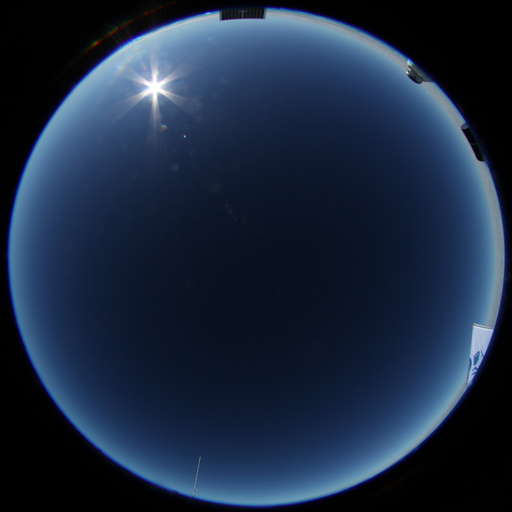HRCAM3: the high resolution all-sky camera
HRCAM3 (High Resolution CAMera 3) is a digital SLR camera (Canon EOS 50D; 15 megapixels) equipped with a fish-eye lens (Sigma 4.5-mm f/2.8) for all-sky coverage on a 1.6 crop sensor. It was installed in PLATO-R at Ridge A during January 2012. It takes images of the sky above Ridge A every few minutes for the purpose of determining the cloud cover, sky brightness, sky transparency, and aurora distribution.
 An HRCAM3 image taken in late January 2012, after the U. Arizona and UNSW team had left Ridge A. The solar panels are at the top of the image, Ubob is at 40 degrees CW, HEAT at 60 degrees, the SCAR flag at 110 degrees, and the meteorological tower at 200 degrees. North is at approximately 20 degrees.
The
image reaches very close to the horizon in all directions.
An HRCAM3 image taken in late January 2012, after the U. Arizona and UNSW team had left Ridge A. The solar panels are at the top of the image, Ubob is at 40 degrees CW, HEAT at 60 degrees, the SCAR flag at 110 degrees, and the meteorological tower at 200 degrees. North is at approximately 20 degrees.
The
image reaches very close to the horizon in all directions.  The prototype HRCAM instrument (this one was deployed to Dome A in January 2010). The fish-eye lens is flush with the top, and
does not have a window. The reflective metal cover is designed to
shed snow, and have low emissivity so that it can be heated
efficiently. The holes on the bottom left are for a dehumidifying
system. The single Milspec connector provides 24VDC power and a
100Mbps LAN connection. The enclosure includes an ARM-based computer
running Linux (HRCAM3 uses a Parvus ISIS-XL with an Intel atom processor). The camera is controlled via a USB connection using
gphoto2. The instrument is designed to operate down to -80C. The raw
images are stored on an array of four spinning hard-disks inside
PLATO. Exposure times vary from 1/2000th of a second to 120 seconds
depending on the sky brightness, and are automatically set by the
software. Thumbnail images (6kB in size) can be sent back via PLATO-R's
Iridium satellite link. Our aim is to use the raw images to extract
quantitative information on sky brightness in the three camera
filters.
The prototype HRCAM instrument (this one was deployed to Dome A in January 2010). The fish-eye lens is flush with the top, and
does not have a window. The reflective metal cover is designed to
shed snow, and have low emissivity so that it can be heated
efficiently. The holes on the bottom left are for a dehumidifying
system. The single Milspec connector provides 24VDC power and a
100Mbps LAN connection. The enclosure includes an ARM-based computer
running Linux (HRCAM3 uses a Parvus ISIS-XL with an Intel atom processor). The camera is controlled via a USB connection using
gphoto2. The instrument is designed to operate down to -80C. The raw
images are stored on an array of four spinning hard-disks inside
PLATO. Exposure times vary from 1/2000th of a second to 120 seconds
depending on the sky brightness, and are automatically set by the
software. Thumbnail images (6kB in size) can be sent back via PLATO-R's
Iridium satellite link. Our aim is to use the raw images to extract
quantitative information on sky brightness in the three camera
filters.
Contacts
Original design: Daniel Luong-Van
Construction: Colin Bonner, Luke Bycroft, Campbell McLaren, Michael Ashley, Nick Tothill
Principal Investigator: Michael Ashley
Participating institutions in alphabetical order
 |
University of New South Wales, Australia |
